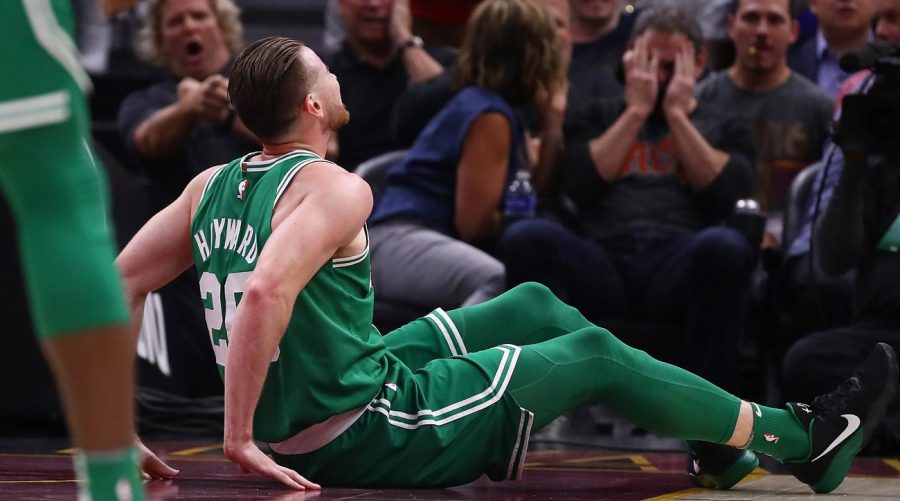Pain through a different lense: Gordon Hayward and the way we look at injuries
November 6, 2017
You’ve probably seen the video.
When Gordon Hayward, all-star forward for the Boston Celtics of the NBA went down with a severe injury in his team’s first game of the season, the replay of the incident was all over social media and the rest of the internet in an instant. As Hayward laid motionless under the basket after a collision with LeBron James, TV cameras focused in on Hayward and his injured left leg. Hayward’s leg and ankle were in a position that appeared so unnatural that it was enough to elicit gasps from commentators and fans in the stadium alike. Hayward was stretchered out of the building quickly, but the image of one of the game’s star players going down with a gruesome injury completely killed the mood of the joyous NBA opening night.
Hayward’s injury was diagnosed shortly after as a fractured tibia and dislocated ankle in his left leg, ending his season 5 minutes after it had started. He is slated to make a full recovery and is expected back next season.
Hayward is beginning a long road to recovery right now, a process all too familiar to athletes. The coming months will be for crucial for him and his NBA career, and hopefully he will be able to return to the all-star level he once was at. However, the fact that the injury was so disturbing and the images associated with it will follow Hayward for the rest of his athletic life. Just ask Kevin Ware.
Ware sustained an infamous injury as a sophomore playing in the Elite 8 of the 2011 NCAA men’s basketball tournament for the Louisville University Cardinals. After he jumped up to contest a jump shot, Ware landed awkwardly and suffered a fracture of the tibia, the same injury sustained by Hayward. Ware’s bone protruded from his right leg, and the replays of the incident were so disturbing that CBS warned viewers of the extremely graphic nature. Similarly to Hayward, the video of Ware’s injury was shared incessantly on social media and was a focal point of discussion as Louisville went on the win the NCAA title.
If you type the name Kevin Ware into a search engine, the first results are purely related to his injury. Ware’s basketball career has continued in Europe, but he is still mostly remembered for his tibial fracture.
It remains to be seen if Hayward’s career will be defined by his injury in the same way that Ware’s was, but it appears unlikely. The way the media treats major injuries seems to be influenced by a variety of factors unrelated to the actual event itself. Ware’s career, and most likely his life outside of basketball, has been effected enormously since the injury. Ware was an unknown role player on a college basketball team who shot into fame for a unfortunate reason. The widespread media coverage and inevitable association of the player to the injury has had a much longer impact on Ware’s life than the eight months it took for him to physically recover from his injury.
The pictures of Ware’s injury that can be seen with a simple google search are disheartening, and not just for their graphic nature. The pictures do not even show Ware’s face, they are enhanced so that only Ware’s leg is shown. Whether intentional or not, the media’s portrayal of Ware’s injury was dehumanizing. Focusing only on the injury and not the person that it happened is not fair. In comparison to Gordon Hayward, Ware’s treatment by the sports world was criminal. Hayward’s injury has not been nearly as sensationalized in the media and when it has been covered much of the focus has been on Hayward’s personality and previous accomplishments in his basketball career.
The reasons for this difference in coverage between Hayward and Ware are not simple, with complex issues such as race at play. The different coverage by the media of these two injuries mirrors other situations in our country in which the media undeniably casts black people in a more a negative light than white people. Whether our country’s mass media publications intentionally do this can be debated, but there can be no doubt that a bias exists in the way we portray individuals in the news, as demonstrated by the opposing treatment that two athletes in similar situations received.
Hayward’s injury is more than just a tibial fracture. The recovery process that Hayward must undergo to play basketball again will test him physically and mentally, and he and others are unlikely to ever forget the graphic nature of his injury. There’s still more to it though. This unfortunate event demonstrated the way a person’s race influences our country’s perception of things completely unrelated to the issue of race, in this case two athletes who suffered debilitating injuries.


